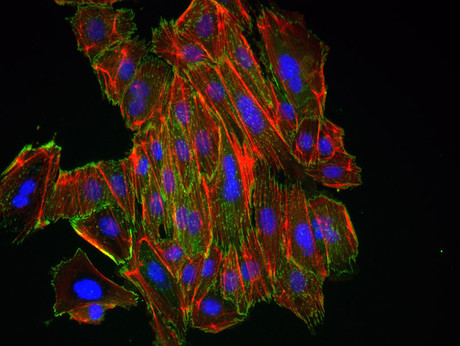Newly discovered microRNA found to regulate tumour cell mobility

Swiss researchers have revealed how cancer cells can reactivate a cellular process that is an essential part of embryonic development, allowing them to leave the primary tumour, penetrate the surrounding tissue and form metastases in peripheral organs. Their research has been published in the journal Nature Communications.
During an embryo’s development, epithelial cells can break away from the cell cluster, modify their cell type-specific properties and migrate into other regions to form the desired structures there. This process, which is known as an epithelial–mesenchymal transition (EMT), is reversible and can also proceed in the direction from mesenchymal cells to epithelial cells (MET). It is repeated multiple times during embryonic development and ultimately paves the way for the formation of organs in the human body.
Although this is a completely normal process during embryogenesis, it also plays an important role in the spread of tumour cells within the body and in the formation of metastases. Scientists have found in recent years that tumour cells are able to reactivate the EMT/MET program, thus obtaining characteristics of stem cells and developing increased resistance to both classical and state-of-the-art targeted cancer therapies. An EMT also makes it easier for cancer cells to break away from the primary tumour, to penetrate into surrounding tissue and into blood vessels, to spread throughout the body and to form metastases in distant organs, which is ultimately responsible for the death of most cancer patients.
Seeking an insight into the molecular processes that regulate the cellular EMT program, researchers from the University of Basel focused specifically on microRNAs, a class of very short non-coding RNAs with a considerable effect on gene regulation. They identified a hitherto unknown microRNA, miR-1199-5p, that induces epithelial cell behaviour and impedes the malignancy of tumour cells, as well as their potential to form secondary tumours.
The newly discovered microRNA was found to prevent the synthesis of a specific protein, the transcription factor Zeb1, which activates EMT/MET — but if it is missing, the EMT process is prevented. Zeb1 also suppresses the expression of miR1199-5p in what is known as a negative feedback loop, whereby the two molecules regulate one another reciprocally.
The scientists hope their insights into the molecular networks for regulating EMT/MET plasticity may one day enable the development of new intervention strategies to combat the development of malignant tumours and the formation of metastases, such as in the case of breast cancer.
ADHD may be linked with an increased risk of dementia
An adult brain affected by attention deficit hyperactivity disorder (ADHD) presents modifications...
Placebos appear to reduce PMS symptoms
Women affected by premenstrual syndrome (PMS) appear to experience less intense and debilitating...
Medicinal cannabis linked to long-term health benefits
As scientists find a way to improve the effectiveness of CBD, a separate study shows that...




